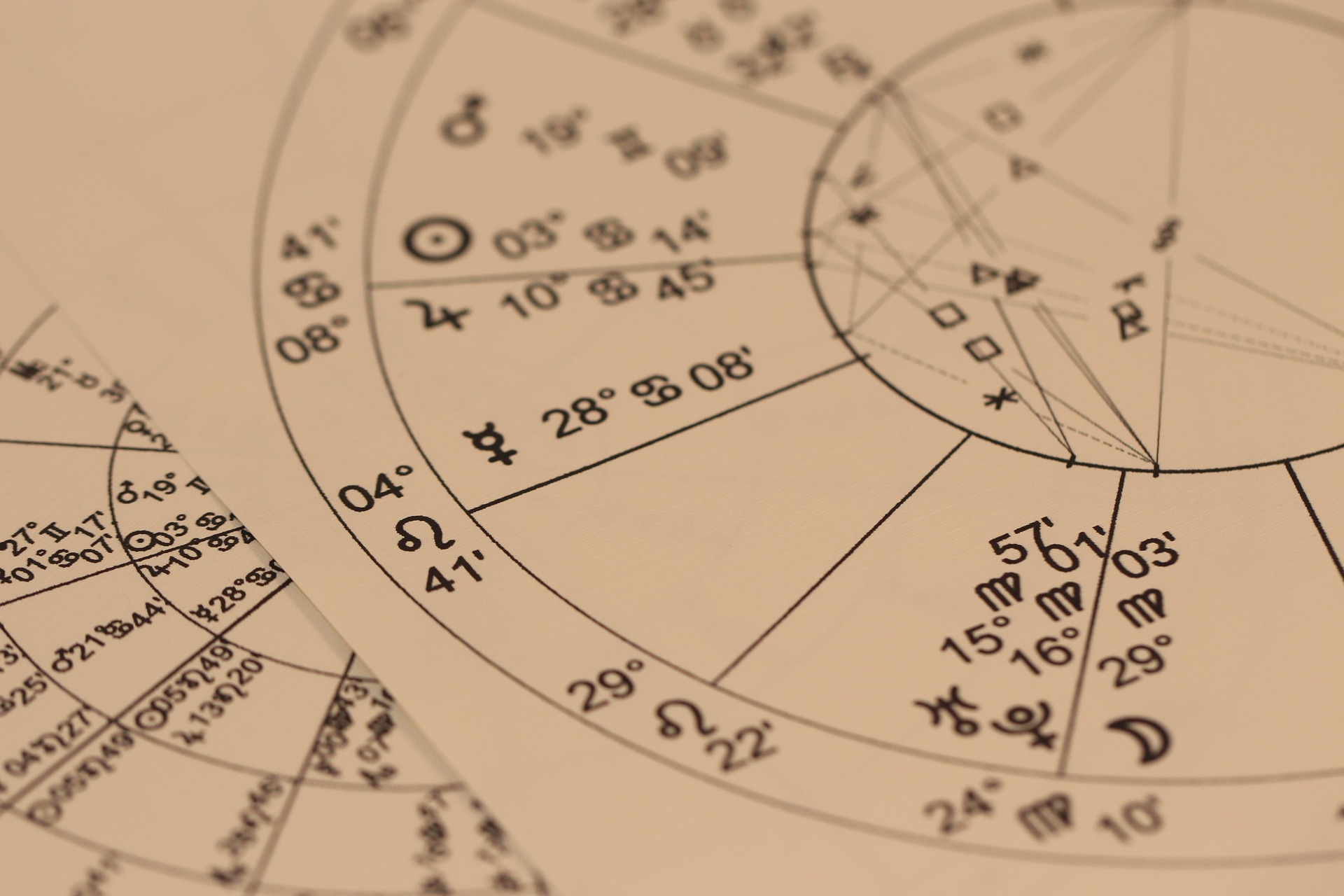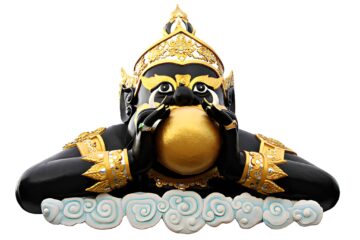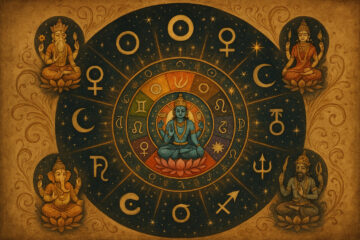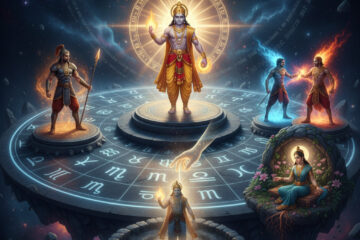This is a practical guide on how to make your horoscope in Vedic astrology and how to begin reading it like an astrologer. Modern software can generate a chart in seconds. That’s the easy part. The real work is learning what you’re looking at — signs, houses, planets, dignity, divisional charts, Lagna, Arudha, timing. What you’re building here is not a meme horoscope. It’s a karmic map.
1. Building Your Birth Chart (D1) and Why Software Is Not the Point
The main chart in Jyotiṣa is the D1 chart, also called the Rāśi chart. It’s the 360° zodiac divided into twelve signs of 30° each. This chart shows the broad architecture of your life: personality, health, mind, career, love, wealth, past patterns, future pressure points.
You can generate your chart using free tools like JHora. You enter birth date, birth time, and birth location; the software calculates planetary longitudes and lays them into houses. In classical practice this took hours of hand calculation. Now it’s instant. But software is only a mirror. It does not interpret for you. You still have to see yourself in it.
When you first open JHora, what you get is your D1. That is the “main body” of the horoscope. Every other layer refines it.
2. Divisional Charts (Vargas): The Hidden Layers of the Horoscope
To really understand how to make your horoscope in Vedic astrology, you can’t stop at the D1. Classical astrology goes deeper by dividing each sign into smaller portions. These are called divisional charts or vargas. Each varga isolates a domain of life and magnifies it.
Key divisional charts:
- D1 (Rāśi): The full-life blueprint. Identity, body, themes of existence.
- D2 (Hora): Wealth, resources, assets.
- D3 (Drekkāṇa): Siblings, courage, initiative.
- D4 (Chaturthamśa): Property, land, vehicles, inherited fortune.
- D7 (Saptamśa): Children, fertility, legacy.
- D9 (Navāmśa): Marriage, dharma, deeper strength and dignity of planets. The most important chart after D1.
- D10 (Daśāmśa): Career, public role, authority, professional standing.
- D12 (Dvādaśāmśa): Parents, ancestry, inherited tendencies.
- D24 (Chaturviṁśāmśa): Education, learning, refinement of intellect.
- D30 (Triṁśāmśa): Misfortune, recurring obstacles, vulnerability.
- D60 (Ṣaṣṭiāṁśa): Karmic residue from previous births; ultra-fine calibration of destiny.
Each varga is a lens. D1 says “career matters.” D10 says “this is how that career actually behaves.” D1 says “relationship and marriage exist.” D9 says “this is the quality and durability of that bond.”
Why D9 (Navāmśa) matters so much:
D9 shows the deeper strength of a planet — whether it has integrity and endurance. A planet that looks strong in D1 but falls apart in D9 often gives early success that erodes. A planet that looks weak in D1 but sits with dignity in D9 may mature later in life, becoming a source of stability and purpose. This is one of the most important interpretive rules in real chart work.
How are these charts actually built? Each divisional chart slices each 30° sign into equal parts:
• The D9 divides each sign into nine segments, creating 108 Navāmśa slots across the zodiac.
• D10 divides each sign into ten segments. And so on.
So two planets in the same sign in D1 may fall into very different placements in D9. One may land in strength; one may fall into distress. That’s why you can’t read only the surface chart and call it analysis. Layering is the work.
Rule to remember: a divisional chart can refine or delay an outcome, but it cannot fully override a planet that is broken in D1. D1 is the ground. Divisionals are the texture.
3. The Ascendant (Lagna): Your Entry Point Into This Life
Your Ascendant, or Lagna, is the sign that was rising in the east at the exact moment you were born. It becomes House 1 of your chart — your physical body, baseline temperament, life-force, and the way you confront reality.
The order of the signs is fixed and always cycles in this sequence:
1. Aries
2. Taurus
3. Gemini
4. Cancer
5. Leo
6. Virgo
7. Libra
8. Scorpio
9. Sagittarius
10. Capricorn
11. Aquarius
12. Pisces
When you generate your chart (for example, in JHora), you’ll usually see the North Indian diamond-style layout. Each “box” is a house. The number inside the first house tells you your rising sign. If you see “10” in the first house, that means Capricorn is rising. Capricorn becomes your Lagna. Saturn becomes your Lagneśa — Ascendant lord.
From there, the houses follow in order. If Capricorn is the 1st, then Aquarius becomes the 2nd, Pisces becomes the 3rd, Aries the 4th, etc. The chart is literally a wheel of 12 houses starting from your Lagna and wrapping all the way back to itself.
Why Lagna matters: the Lagna sets the reference frame for everything else. Which houses are benefic. Which houses are difficult. The planets that are functional benefic for you. Which one becomes a functional malefic. Without Lagna, you cannot talk about “good” or “bad” in a serious way.
4. Arudha Lagna (AL): What the World Sees When It Looks At You
In most modern software you’ll also see cryptic labels like AL, A2, A5, A7. These are Arudhas, which means “reflections” or projections.
Arudha Lagna (AL) is not who you are. It’s the image of you. It’s how the world reads you — your projected persona, brand, status, perceived competence, desirability, threat level, mystique.
Lagna: the actual self.
Arudha Lagna: the perceived self.
This distinction is essential in high-stakes readings. Someone can have a fragile Lagna (sensitive, private, easily wounded) but a powerful Arudha Lagna (other people read them as confident, intimidating, high-value, untouchable). The inside is not always what the world thinks it sees.
There are also Arudhas for other houses:
• A2: projection of wealth and speech. A5: projection of creativity, brilliance, romantic aura. A7: projection of partnership energy.
Compare the actual house to its Arudha and you see where life is honest… and where it’s theatre. This is the difference between truth and presentation. Between essence and mythology.
5. Long and Short Ascension: Why Birth Time Matters So Much
Not every sign rises for the same length of time. Because of the Earth’s axial tilt and your latitude, some signs move across the horizon quickly and others linger. Near the equator, the differences are modest. Farther from the equator, some signs whip past in minutes while others sit on the horizon for longer stretches.
Practically, this means two people born minutes apart can have different ascendants, and therefore different house structures, especially at higher latitudes. A “wrong by 10 minutes” birth time can generate a wrong Lagna. That changes everything.
When you generate your birth chart in software like JHora, it automatically accounts for location and ascensional differences using ephemerides and astronomical math. Ancient astrologers did this by hand with tables and instruments. You are standing on their shoulders every time you click ‘calculate.’
6. How to Start Reading Your Own Chart
This is the minimum practice to begin how to make your horoscope in Vedic astrology and actually read it instead of just posting it:
- Identify the Lagna (Ascendant): Which sign is rising? Who rules it? Where is that ruler placed, and in what dignity?
- Check D1 vs D9: Are your key planets strong in both? Strong in D1 but weak in D9 often means “starts strong then fades.” Weak in D1 but strong in D9 often means “slow start, long-term maturity.”
- Look at the 10th house in D1 and the D10 chart: This gives you career style and career execution.
- Note Arudha Lagna (AL): How do you appear? Is the image aligned with who you really are? Or is there a split you are constantly managing?
- Track dignity and placements: Which planets are exalted, in own sign, debilitated, combust, retrograde, hemmed, aspected by benefics or malefics? Strength tells you who can actually act on your behalf in this life.
Do this for yourself. Then do it for two or three people you know well. Patterns will begin to surface in a way that no generic “sun sign description” could ever touch. The chart will stop feeling like mysticism and start feeling like a psychological x-ray of karma in motion.
Important Notes
Is the degree of Arudha Lagna (AL) the same as the main Lagna?
No. Arudha Lagna is not simply the first-house cusp repeated. Its degree is tied to the degree of the Lagna lord (Lagneśa), not the Lagna itself. AL is a projection. Lagna is identity. They do not have to agree — and often they don’t.
Can JHora export charts directly to Word?
JHora does not natively generate .docx files. The usual workflow is: generate chart → take a screenshot or print preview → paste into Word or PDF. This is how most working astrologers create deliverables for clients.
Can I treat D1 and D9 like a binary truth table?
You are close, but don’t oversimplify. D1 is the promise. D9 shows depth, dharma, and longevity. Strong in both = stable and durable. Strong in only one = conditional, situational, or delayed. Weak in both = needs work. But remember: D9 is not the only divisional. For career, for example, you must also read D10 (Daśāmśa).
Where can I download JHora safely?
JHora is free. Search “JHora astrology software download” and choose the official Jyotiṣa community source or a trusted classical astrology forum. Avoid altered builds. You don’t want bad ephemeris data.
FAQ — Lagna, Arudha, Divisionals, Timing
What is the difference between Lagna and Arudha Lagna?
Lagna is you — body, temperament, the raw self. Arudha Lagna is the mask — how you are seen, interpreted, mythologized. In predictive astrology, Arudha Lagna is powerful for judging visibility, social reputation, and material presentation.
Can a planet that is weak in D1 but strong in a divisional chart still help me?
Yes, but with conditions. A planet weak in D1 but strong in D9 or D10 can still show up and help in that planet’s specific domain (marriage, dharma, career, etc.). But it may not be able to rewrite the entire life story if it’s fundamentally injured in D1. The main chart is the ground reality. Divisionals refine and time that reality.
Why is D9 (Navāmśa) treated so seriously?
D9 is considered the chart of dharma, marriage, maturity, and inner alignment. It shows what survives erosion. D9 reveals the deeper potential of planets — their integrity, their ability to sustain meaning under pressure. That’s why traditional astrologers refuse to read marriage or long-term spiritual development without D9.
Do long and short ascensions really change interpretation?
They mainly affect calculation: which sign becomes Lagna at a given minute, at a given latitude. The interpretive meanings of the signs themselves do not change. But this is why birth time accuracy matters. A 7-minute error in birth time can put the Lagna in a different sign entirely — which means a different lord, different house structure, different karmic map.
What are A2, A5, A7, etc. used for?
They are Arudhas of specific houses — projections of wealth and speech (A2), creativity and intelligence (A5), partnership and attraction (A7), and so on. They show how those areas look from the outside. Comparing each Arudha to the actual house shows you the gap between reality and presentation — where you are honest, where you are curated, where you are misunderstood.
Conclusion — Your Chart Is Your Field of Work
Learning how to make your horoscope in Vedic astrology is not about worshipping fate. It’s about literacy. You are learning where the pressure lives, where the support lives, where the illusion lives, and where the evolution is already waiting for you to meet it. Start with Lagna and D1. Layer D9. Watch how Arudha shows the mask. The language will start speaking back.
Ask your karma. Decode your chart at Much Needed Astro.



